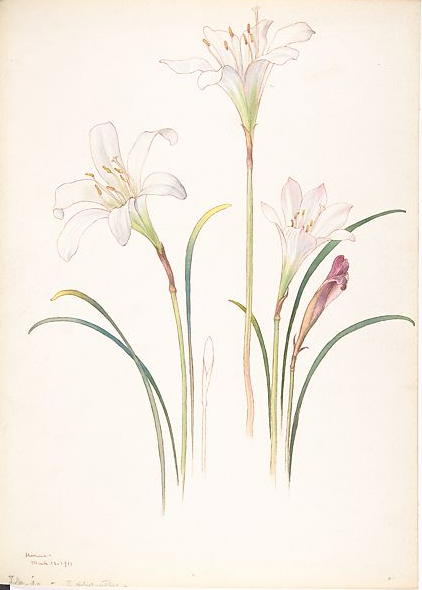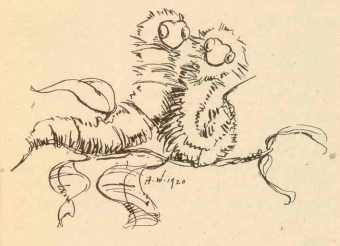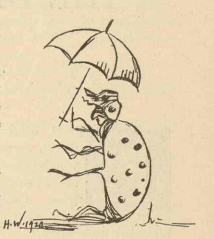The House of Broken Things
From The Brownies’ Book, 1921
By Peggy Poe
Annotations by Kathryn T. Burt
Down South in Georgia, it had been springtime so long that it was nearly time for summer. Old Mrs. Southwind[1] had decided to stay right at her work, and this had made Old Mr. Wolfwind[2] afraid to make any more visits to Georgia, so he stayed up North and howled about.

All that day Boy, Waddy, and Happy had played in the big yard and garden and they had done some very naughty things, things that boys who love the kind of God who gave them the beautiful things you find in a garden should never do; but at last Happy went home to supper and to feed his black rooster and red hen. When he came back the little path to Colonel Jones’ house was very bright. Miss Lady Moon was smiling and she seemed so near that Happy was sure he could touch her if he had a long pole; her moonbeams were so brilliant that it made the cotton patch seem like day time. When he went around to the big, front steps there was Boy, Waddy, and Mrs. Colonel Jones in her white dress and she looked like one of the white lilies herself. Boy and Waddy were as clean and shiny as the moonbeams. Happy was glad Mammy Tibbets had let him wear his white suit, and he was smiling finer than the biggest moon could ever smile. Mrs. Colonel Jones cuddled Happy down by her side and they all sat very still listening to the mocking bird who sings at night down in Georgia; but after awhile Mrs. Colonel Jones sighed, just like she had thought of something not very nice.
“Let us go for a walk in my garden,” said she, taking Waddy’s hand while Boy and Happy followed her softly, because it seemed as if in that moon-lighted garden no one wanted to make a noise. They passed the fig tree, where the baby figs come out without any blossom dress on like other baby fruits. They went very softly pass the bushes where the yellow roses seemed to rain down; they passed the bed where the pansies live and each small purple face was dimpled with dew; then they came to the corner where the great white lilies grow with their golden throats.
“Oh! how I do love my lilies,” said Mrs. Colonel Jones stopping over to touch a very large lily, and behold—the white petals opened wider and wider until that lily was a beautiful white house and Miss Lady Moon flashed her most brilliant moonbeam into it so that it seemed like day time. Mrs. Colonel Jones gave a little cry of surprise and then just when the boys were going to ask about it, there stepped up Old Mr. Toad, dressed in a beautiful green and gray suit,—but one of his feet was bound up in a cloth and he limped terribly, as he came forward bowing to Mrs. Colonel Jones, and the lady who liked all the creatures in her garden felt very sorry for him.
“Oh, Friend Toad! what has happened to you?”
“Well, today when I was guarding your watermelon patch, a little boy came along and hit me with a stick, I don’t know why he did it. I was only guarding your melons from the worms so you would have some nice ones.”
“How could anyone hurt our best garden friend? Do you know his name?”
“I do not, dear lady; but won’t you go into the Lily House? White Butterfly lives there. Generally it’s a very nice house to visit, but to-night it is a House of Broken Things. I am guard at the door, so I will let you in.”
“And the three boys, may they come in?”
“Oh yes, but I am afraid they won’t enjoy it.”
They all walked in, but when Happy passed the poor, hurt toad he hung his head in shame. At the door of the Lily House, White Butterfly met them. She wore a nurse’s apron and carried medicines, spoons, and bandages. She seemed very sad too.
“Oh! I am so glad to have visitors; it seems so sad in here. Most of the time my Lily House is very gay, but today so many dreadful things have happened in the garden that I just had to turn my house into a House for Broken Things, but now that you and the little boys have come, maybe you can help me cheer things up.” The White Butterfly went very softly down the white hall with its golden carpet as soft as pussy fur. Soon she stopped by the side of a wee white bed, and there lay two tiny baby Caterpillars, only you couldn’t see much of them for bandages and tears, they were hurt so.
The next bed had poor old Beetle in it; he seemed so very ill with a crushed leg. “Old Beetle had been working in the wood pile when three little boys came along and pelted him with sticks and smashed his leg; it’s so badly hurt that I am not sure I can ever cure him,” said White Butterfly. In the next bed they found Lightening Bug, only he would never be a real lightening bug again, because, you see, when he was carrying his lantern about the garden to make it lighter until Miss Lady Moon came, a very small fat boy came and caught him and put him under a glass and the glass had broken his beautiful lantern off, so that now, even though he would get well, he never could help light the pretty garden again.

The White Butterfly said to Mrs. Colonel Jones, “This is very sad indeed. These little caterpillars were crossing the garden walk this morning, hunting some weeds, to eat, when a boy came along and put his hard shoe right down on them and broke most every part of them. I do so hope they get well.” Boy hid his head in his hands. They went to another bed, and there lay a little Honey Bee, and White Butterfly told about here! “Miss Honey Bee had heard you say that you hoped you would have some real good honey this year, so she went into the trumpet flower, and as she was coming out with a great load of honey, a boy whacked her with a stick and broke her wing. I think maybe it will be better tomorrow, but I know one thing, if folks don’t stop hurting the bees, there won’t be any honey for the hot biscuits.” Waddy looked over at Miss Honey Bee and hung his head in shame.
In the next bed lay Granddaddy Longlegs, propped up with milkweed pillows; one of his legs was gone, broken off, and he seemed to be in such pain. The White Butterfly gave him a week drop of medicine and said to Mrs. Colonel Jones:
“Granddaddy was out under the house steps asleep when a boy came and said to him: ‘Granddaddy gray, tell me where the cows are, or I’ll kill you right away.’ Now you know Granddaddy is so old that he couldn’t possibly know where the cows are, so he couldn’t tell that boy where they were, and that cruel boy dropped a rock on him and cut off his leg.”
“Oh! how terrible!” said Mrs. Colonel Jones.
In the next bed were three baby Ants, asleep; White Butterfly said someone had dug up their house and they had no home to go to. But it was the very next bed that made the boys feel sad. In it lay Lady Bug’s two wee children; they were crying very hard. White Butterfly told about them.

“Someone saw Lady Bug when she was cleaning house for the strawberries and called ‘Lady But fly away home; your house is on fire and your children will burn!’ Of course this frightened Lady Bug very much and just as she started to run home, someone put her into a box and put a lid on it and carried it off. Now her children were alone at home, and when their mother didn’t come home, they started out to find her. I was afraid something would hurt them so I brought them here, and after giving them some supper I put them to bed, but the poor little things just keep crying for their Mama.”
Just then Happy stepped up beside the bed and took a little box from his pocket and opened it. Out hopped Lady Bug right among her babies. My! what a happy family they were, but Happy wasn’t very happy, he was so ashamed. He hid his fat little face behind Mrs. Colonel Jones’ dress.
As they walked along the white hall, White Butterfly began crying every so softly, for there in a small bed lay a small yellow Butterfly. It looked like a piece of fine lace. One of its pretty wings was sadly broken.
“This is my little boy,” said White Butterfly. “I have fixed his wing the best I could. Oh! do you think he will get well?”
Mrs. Colonel Jones stooped over the baby butterfly and looked at the broken wing. “Why yes; I think it will be well in a short time. There, don’t worry! but how did this happen?”
“Oh! it was awful! You see, I told him to play out in the pansy bed, as our garden has always been so safe and happy. I never thought anything could happen to him. He had just fluttered down to kiss a pansy girl, when a boy flopped his hat on him and broke his wing. I got him home right away. I hope he’ll get well.”
Boy hung his head, and Mrs. Colonel Jones put her silk shawl over his face. As that was all there was in the Lily House, they bid White Butterfly good night, and thanked poor Mr. Toad for letting them in. They went to the house, and Mrs. Colonel Jones gave each boy a large slice of chocolate cake.
The next day, the boys went back to the garden and looked for that Lily House, but although they hunted the garden over and looked into all the lilies, they could not find one that looked like a house. But really there was no need for a Lily House of Broken Things in that garden anymore. For whenever Boy, Happy, and Waddy started to chase or hurt the tiny creatures who lived in the garden, they always remembered the “House of Broken Things” and how sad it was, so they stopped harming the helpless things, the little people of the garden.
Poe, PEggy. 1921. “The House of Broken Things.” The Brownies’ Book, 2, no, 1, (Jan): 8-10.
[1] In an earlier story by Peggy Poe, “The Watermelon Dance,” Old Mrs. Southwind is described as “a very gay lady” who “spends most of her time visiting.” Because she tends to come and go whenever she feels like it during the Winter and Spring, the Georgia folks have to “wait for her to get through visiting before they plant their good things” (263).
[2] In”The Watermelon Dance,” we learn that old Mr. Wolfwind is so named because he comes “howling out of the north” when Old Mrs. Southwind goes visiting and tears up Mrs. Colonel Jones’ garden.
[3] Happy first appears in the very first issue of The Brownies’ Book in a story called “Pumpkin Land.”
Contexts
The Brownies’ Book was a popular children’s magazine edited by W. E. B. Du Bois, who hoped the periodical would “teach Universal Love and Brotherhood for all little folk—black and brown and yellow and white” as well as highlight the voices of writers of color. The magazine covered a wide variety of genres and topics, ranging from serious social and political news in the “As the Crow Flies” columns to nursery rhymes and illustrations. As Katharine Capshaw Smith observes, Du Bois made an effort to include pieces which sought to “inspire activism in child readers” and to make space for young writers in the monthly installments (161). However, there was also plenty of escapist stories and poems for young readers to enjoy, and writers like Peggy Poe particularly enjoyed combining southern folk lore and dialects with fairy tale tropes. Although scholars like Fern Kory have critiqued Poe’s work for attempting to fit black narratives into white literary traditions and creating a “problematic hybrid of the most didactic sort of fairy story and a conventional plantation story” (103) the significance of these early attempts to carve out a space for black fantasy stories cannot be overstated.
Resources for Further Study
- Poe, Peggy. 1920. “Pumpkin Land.” The Brownies’ Book, 1, no. 1 (Jan): 3-7.
- Poe, Peggy. 1920. “The Watermelon Dance.” The Brownies’ Book, 1, no. 9 (Sep): 263-265.
- Smith, Katharine Capshaw. 2014. “The Crisis Children’s Page, The Brownies’ Book, and the Fantastic.” In Protest and Propaganda: W. E. B. Du Bois, the Crisis, and American History, edited by Amy Helene Kirschke and Phillip Luke Sinitiere, 156-172. Columbia: University of Missouri Press.
- Kory, Fern. 2001. “Once upon a Time in Aframerica: The ‘Peculiar’ Significance of Fairies in the Brownies’ Book.” Children’s Literature 29, 91-112. New Haven and London: Yale University Press.
Pedagogy
Peggy Poe’s short story asks us to see animals as people with families, homes, and dreams just like us. If you want more ideas for talking with the young people in your life about the importance of compassion for animals, check out the following resources:
- For advice on incorporating animal literature into a curriculum or your child’s life, see Carolyn L. Burke and Joby G. Copenhaver’s piece, “Animals as People in Children’s Literature.”
- For an introduction to the psychology of empathy and ideas for teaching your child to be empathetic, see the Humane Society’s “The Empathy Connection.”
- For ideas on specific activities you and your child can do together to learn about animals and compassion, see this Sunny Day Family blog post “How to Be Kind to Animals: 10 Ideas for Kids with Free Printable.”